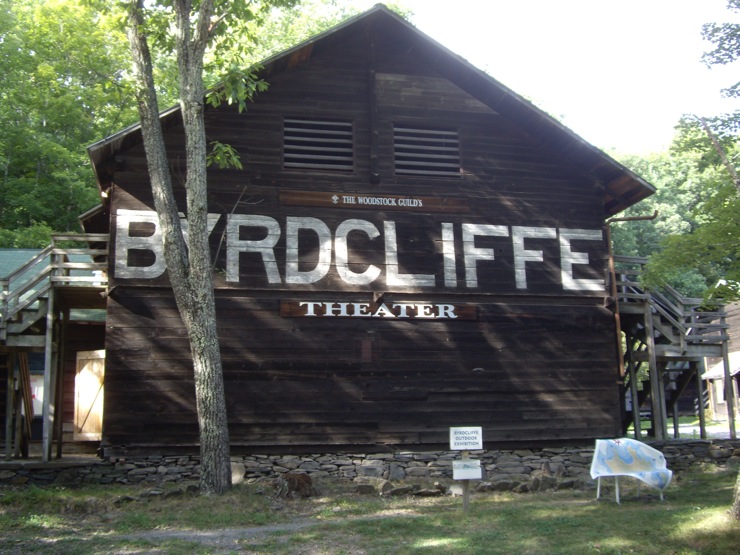- Byrdcliffe Colony
Infobox_nrhp | name =Byrdcliffe Historic District
nrhp_type = hd

caption =
location = Upper Byrdcliffe Way, Woodstock, Ulster County,New York
lat_degrees = 42
lat_minutes = 3
lat_seconds = 14
lat_direction = N
long_degrees = 74
long_minutes = 8
long_seconds = 17
long_direction = W
locmapin = New York
area =
built =1902
architect= Whitehead,Ralph Radcliffe; Et al.
architecture= Stick/Eastlake, Other
added =May 07 ,1979 cite web|url=http://www.nr.nps.gov/|title=National Register Information System|date=2008-04-15|work=National Register of Historic Places|publisher=National Park Service]
governing_body = Private
refnum=79001643The Byrdcliffe Colony, also called the Byrdliffe Arts Colony or Byrdcliffe Historic District, was founded in 1902 near
Woodstock, New York by Jane andRalph Whitehead [ [http://antiquesandthearts.com/CS0-06-10-2003-11-49-23 Antiques and Art Online: "Byrdcliffe Arts Colony"] ] and colleagues,Bolton Brown (artist) andHervey White (writer). The Arts and Crafts Movement arose in the late nineteenth century in reaction to the dehumanizing monotony and standardization of industrial production. It was created as an experiment in utopian living inspired by the arts and crafts movement. [ [http://www.marist.edu/summerscholars/00/history/brdclif.htm A Historical Colony of Art: Byrdcliffe] ] It remains focused on the development of artistic vision.Location
Woodstock is surrounded by the
Catskill Mountains ofNew York State . Byrdcliffe lay on 1,500 acres (6 km²) of south-facing mountainside above Woodstock. This location provided the rustic landscape meant to inspire and elevate this art community as well as its offering of close proximity to New York City.History
For many years, Whitehead had held the idea of creating an Arts and Crafts community where all the arts would come together, including painting, sculpture, music, metalwork and furniture making. After a failed attempt to establish a community near Albany, Oregon, he scouted the East Coast for a suitable site.
After finding an appropriate site near Woodstock, he called the site Byrdcliffe (a melding of his and wife Jane's middle names).
Artists, writers, musicians, social reformers, and intellectuals came from across the country to stay at Byrdcliffe and gain inspiration from the setting and people with shared artistic goals. Facilities included studios for painting, weaving, pottery, metalwork, woodworking; cottages with bathrooms and sleeping porches; a library, and a rambling villa for Whitehead and his family. He built "White Pines" as his residence with a skylit cathedral ceilinged weaving room overlooking a picturesque view across the Woodstock Valley.
The artist colony of Byrdcliffe failed to fulfill its goals of a self-sufficient arts community. It became too expensive and Ralph Whitehead’s dominating personality became a confining force. Byrdcliffe survived for almost 30 years under Whitehead’s vision until his death in 1929.
After Ralph Whitehead's death in 1929, his widow, Jane, and son Peter struggled to keep the colony alive. After Jane's death in 1955, Peter sold much of the land to pay taxes and maintenance on the heart of the colony which he kept intact. The Whiteheads intended to preserve Byrdcliffe "for the purpose of promoting among the residents of Woodstock...the study, practice and development of skill in the fine arts and crafts, as well as a true appreciation thereof..."
Although the
arts and crafts utopian experiment soon ran out of steam, the continuing magic of Byrdcliffe enthralled many notable people including the educatorJohn Dewey , authorThomas Mann and naturalistJohn Burroughs . Isadora Duncan danced at White Pines;Bob Dylan lived in a house at Byrdcliffe in the '60s and early '70s;Joanne Woodward was involved in the River Arts Repertory at the Byrdcliffe Theatre.Merger with Woodstock Guild of Craftsmen
Upon Peter Whitehead's death in 1975, Byrdcliffe was left to the Woodstock Guild of Craftsmen who have continued to maintain and administer programs at the colony. In 1979, the Byrdcliffe Historic District was listed on the National Register of Historic Places in recognition of its historical and architectural significance. Byrdcliffe's cottages have been rented since 1984 only to working artists, maintaining sympathy with the founder's creative vision.
The Byrdcliffe Arts Colony received its name as a combination of Ralph Radcliffe Whitehead’s middle name and his wife’s, Jane Byrd McCall Whitehead, middle name. The colony is still in operation today and is located on 300 wooded acres with 35 unique Arts and Crafts buildings on country pathways in Woodstock, New York.
Woodstock Brydcliffe Guild
Now owned by the Woodstock Byrdcliffe Guild (WBG), a non-profit arts and environmental organization with over 600 members, Byrdcliffe is the oldest continuing arts colony in America. The Woodstock Byrdcliffe Guild is a multi-arts membership organization. Its Kleinert/James Arts Center hosts local and national performing, visual and literary artists. The WBG offers a variety of classes in the arts.
Byrdcliffe is an important regional example of the movement to create various types of utopian enclaves in America. Today, under the management and restoration efforts of the Woodstock Byrdcliffe Guild, Byrdcliffe continues as a place for artists to gain inspiration, live, and work.
ee also
*
Arts and crafts
*Greenwich Village
*History of art
*Provincetown, Massachusetts
*Taos, New Mexico
*Utopia
*Woodstock, New York References
* Byrdcliffe: An American Arts and Crafts Colony (Book by Nancy E. Green, Editor) ISBN 978-0964604209
External links
* [http://www.woodstockguild.org Official Site]
* [http://www.museum.cornell.edu/byrdcliffe/resources/colony.html Cornell University]
* [http://www.albanyinstitute.org/exhibits/byrdcliffe.colony.htm Albany Institute of History & Art]
* [http://findingaid.winterthur.org/html/HTML_Finding_Aids/COL0209intro.htm The Winterthur Library] - Overview of the collection on the Byrdcliffe colony
Wikimedia Foundation. 2010.
